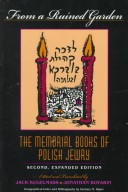Indiana-Holocaust Museum Reprint S.
1 total work
From a Ruined Garden
by Jack Kugelmass, Jonathan Boyarin, and Zachary Baker
Published 1 January 1983
"An indispensable sourcebook...Emphasis falls on the variegated, often joyful, culture of the Polish Jews, on what existed before the garden was ruined." - Geoffrey H. Hartmann, "The New Republic". "From these marvelous selections, one can see an entire culture unfolding. "From a Ruined Garden" accomplishes what editors from hundreds of towns sought to do for their destroyed communities - create paper monuments wherein a bit of that extinguished flame is fanned back to life." - Curt Leviant, "New York Times Book Review". In the years after World War II Polish Jewish survivors of the Holocaust who had made their way to America or Israel resolved to preserve the memory of their destroyed communities by compiling memorial books, narrative accounts of Jewish life in Polish towns before, during, and to some extent after the Holocaust. "From a Ruined Garden" gathers some 65 selections from the nearly one thousand memorial books published since World War II.
The texts describe typical market days, communal institutions, prayer houses, peculiar town types, outstanding personalities, and local customs and legends, as well as everyday life during the Holocaust and the experiences of returning survivors. The book includes a comprehensive bibliography of the memorial books and a gazetteer of place names mentioned in the text. A substantial introduction by the editors illuminates the history of the memorial books and their importance in the construction of memory culture through the response of survivors.
The texts describe typical market days, communal institutions, prayer houses, peculiar town types, outstanding personalities, and local customs and legends, as well as everyday life during the Holocaust and the experiences of returning survivors. The book includes a comprehensive bibliography of the memorial books and a gazetteer of place names mentioned in the text. A substantial introduction by the editors illuminates the history of the memorial books and their importance in the construction of memory culture through the response of survivors.
